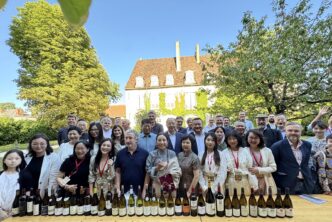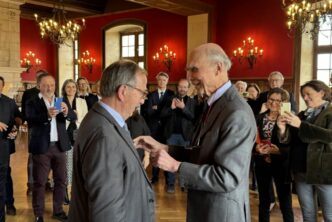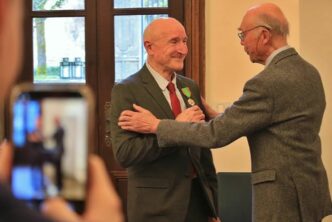The first time Enrico Scavino introduced me to his elder daughter Enrica, she was a really young lady who wasn’t yet working full-time at the family winery. I always appreciate greatly when wine producers want me to meet and to get to know their children, who will one day run the family’s winery; but what struck me most about that encounter was how really well she spoke English. Enrico beamed when I complemented her profusely (back then, the English of most Italian wine producers and their children was much closer to an incomprehensible idiom than to any version of English known to modern man or woman). Enrico then gave me a knowing look and said: “You want to know what happened? It was after my first trip to the USA: I came back home so incredibly upset and embarrassed that I couldn’t even ask how to get to a toilet. So that very same night I got home from the airport, I went to Enrica and told her: tomorrow, you start learning English. And so it was”.
That sort of resolve goes a long way in explaining the man and his wines.
Speaking of memories, I wish I could tell you the first time I met Enrico himself: but the simple truth is I just don’t remember. I guess there wasn’t a side-story to that first meeting that might have helped to embed that encounter in my subconscious. I don’t know. After all, it was a moment in time now too long removed from my current days, and nowadays the cobwebs of time are getting harder to remove from my mind to always enable me to successfully shine alight on the information stored within.
But I do remember the first time I had a wine of his. If you have been reading my work over the years, then it won’t surprise you to know it was the Bric del Fiasc, the Paolo Scavino winery’s most famous Barolo. I was a student in Rome at the time, and had wandered in an old wine shop full of dusty bottles looking for hopefully good buys (an important mission I devoted my spare time to, given I was then a poor university medical student who loved wine). And I did ever get lucky: I found a bottle of his Barolo Bric del Fiasc, still with the old and not so beautiful label, from the 1979 vintage (only the second vintage ever made of Bric del Fiasc, though I didn’t know it at the time). I opened it later that night with wine-loving friends over salumi and cheeses in our favourite neighbourhood watering hole that allowed us to bring wine bottles (provided we also bought some of theirs, which of course we always did). The wine was delicious, and taught me two important lessons: one, that the 1979 vintage in Barolo was a really good one, of relatively easy-drinking wines that were approachable early and had been heavily underrated at the time; and two, that Paolo Scavino was a winery worth getting to know better.
Over the years, I did just that. I visited the winery regularly, where at first I tasted with Enrico only, later on in the company of his daughters too, and later still with his daughters only. In fact, tasting wines was only a part of the thrill when visiting Paolo Scavino: Enrico’s heart beat strongest for his vineyards, and he was always happiest when we had the time to go visit some of them and take a look at both grapes and vines. But he was a very good taster too: one time, at the Belvedere restaurant in La Morra, he served me three different wines marked by three rather faint but different cork-related problems, a valuable wine lesson I cherish to this day. He was a generous man, one who was always kind to me and for whom he always found time; importantly, this even when I was still a university student in my twenties and nowhere close to becoming the wine writer I am today. I have the memory of an elephant for certain things.
Not that I agreed with everything Enrico believed in, or did. I thought he was a little too enamored of his roto-fermenters, and didn’t always find his Barolos gained in depth and complexity with age (at least, not as much as I thought they could and should have, which, in truth, was a problem common to all the strictest of the modernist Barolo producers, or Barolo Boys, as they were then known). I also found some of his wines to show a slightly heavy dosage of new oak, one that did not always age well. But those were and are minor quibbles, for the majority of his Barolos were outstanding and well worth the price they fetched. I have nothing but great memories of many vintages of his Barolo Riserva Rocche dell’Annunziata, the Barolo Cannubi and the Barolo Monvigliero, which for the longest time was the only worthy rival to G.B. Burlotto’s great wine from that same hallowed Verduno site.
Enrico Scavino began working in the family Paolo Scavino winery of Castiglione Falletto in 1951 at the age of 10, meaning he had a whopping seventy-two harvests under his belt. In other words, every time Enrico spoke, I listened even more closely than usual, for it was always a learning opportunity. I have fond memories of the man and my time spent in his company. For sure, his passing leaves a void in my life, for a part of it is inextricably linked to Barolo and to Enrico. He would have turned 83 years old this coming April.
++++++++++++++++++++++++++++++++++++
Enrico Scavino passed away on February 25, 2024, following complications of surgery. He was the grandson of Lorenzo Scavino who founded the original winery in 1921, and the son of Paolo who would go on to set up the eponymous winery after the family estate was split in 1943. Last but not least, Enrico Scavino was also the father of the talented sister duo of Elisa and Enrica, who have followed in his footsteps and now run the company. Among his many claims to fame, and certainly the most important in my books, was his decision to produce the estate’s first single-cru wine from the Fiasco vineyard district. That wine, first made in 1978, was called Bric del Fiasc, and effectively put both the winery and the vineyard district on the quality wine map. That decision was a harbinger of things to come: over the years, the winery confirmed itself to be one of the most interested in producing single-vineyard district wines. Today the estate makes Barolos from the vineyard districts of Rocche dell’Annunziata in the commune of La Morra, Cannubi in the commune of Barolo, Monvigliero in the commune of Verduno, Bricco Ambrogio in the commune of Roddi and the aforementioned Bric del Fiasc in the commune of Castiglione Falletto, but actually farms vines in over twenty different Barolo crus. Enrico Scavino was one of the first producers in the Barolo denomination to jump on the “modernist” bandwagon, meaning greatly reducing yields, introducing roto-fermenters to shorten fermentations while increasing colour and tannins in the finished wines, using new small oak barrels and paying attention to their hygiene. His wines quickly rose to the upper echelons of Barolo quality and were much sought after by wine lovers and wine collectors alike.


 中文
中文



